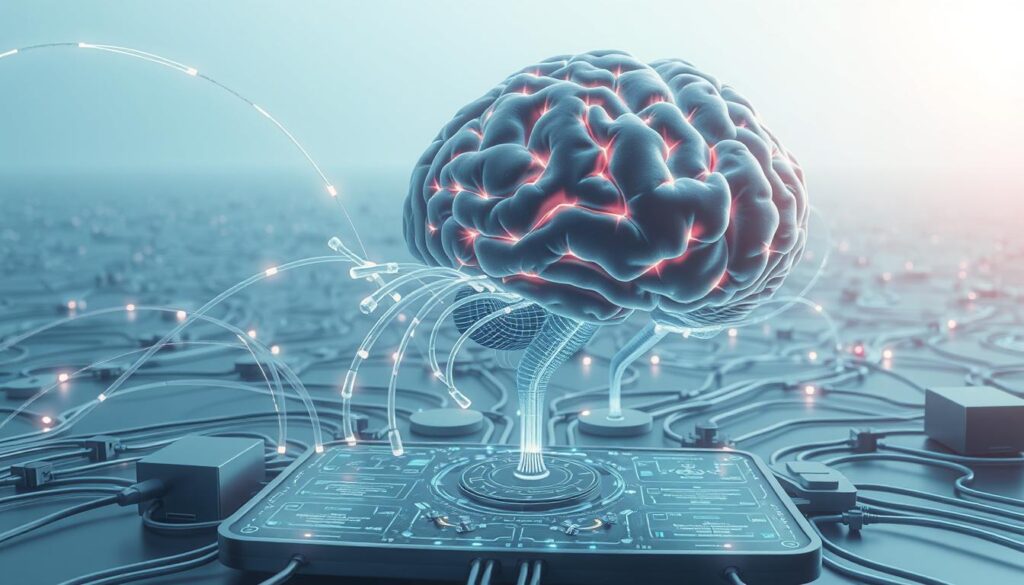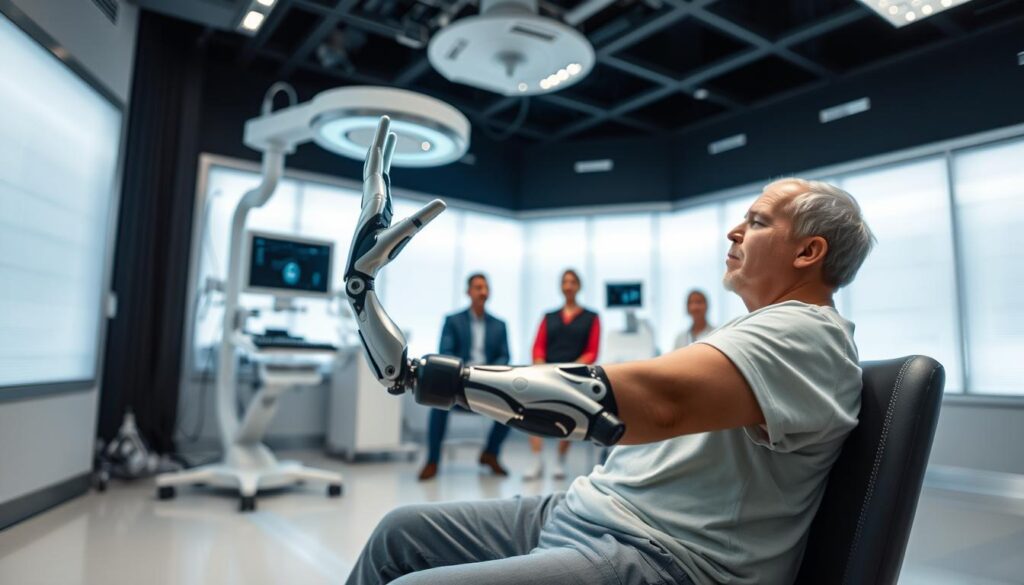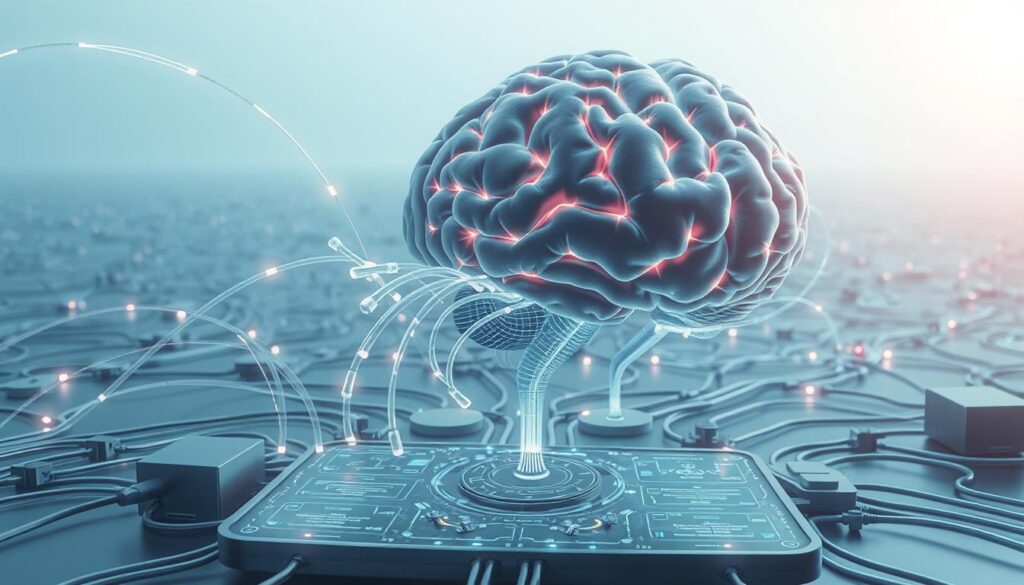
Human Brain Power – Your brain is truly amazing. Every time you pick up a coffee mug, throw a ball, or type on a keyboard, it’s a remarkable sight. This silent talk between your mind and the world around you is something we often overlook.
Scientists at MIT and Stanford have been studying brain abilities for years. The Human Brain Power has about 86 billion neurons. These neurons work together to help you move with incredible accuracy. This allows you to handle delicate objects or swing a hammer with power.
Humans have always been drawn to controlling our surroundings. From ancient cave paintings to today’s brain-computer interfaces, we’ve made great strides. The idea of moving objects with just our thoughts is no longer science fiction. It’s becoming a reality thanks to advanced neuroscience.
Research into brain-object interaction is opening up new doors for people with mobility issues. Patients at rehab centers are testing devices that let them control prosthetic limbs or computer cursors with their minds. This blend of technology and human thought is one of the most exciting areas in medicine today.
Key Takeaways Human Brain Power
- The Human Brain Power uses 86 billion neurons to coordinate precise object manipulation
- Brain-object interaction occurs naturally when performing everyday tasks
- Modern neuroscience is expanding our understanding of brain manipulation capabilities
- Brain-computer interfaces are making thought-controlled objects a reality
- This technology offers hope for people with mobility limitations
- The field combines neuroscience, computer science, and engineering
Understanding the Power of Brain-to-Object Control
The Human Brain Power sends out commands that let us interact with our world in complex ways. This amazing ability is key to our daily lives, yet we often overlook the detailed processes behind it.
Defining Brain-Object Interaction
Brain-object interaction is about how we see, touch, and react to things around us. It’s what lets us pick up a coffee mug or type on a keyboard. These actions depend on complex neural paths that turn our thoughts into actions.
It starts with seeing things, as our brains make mental pictures of objects. These pictures then guide our movements. This brain-to-object talk is so smooth, it feels like magic.
The Fascination with Mental Manipulation
For ages, people have dreamed of moving things with their minds. Stories of telekinesis and sci-fi tales have sparked our curiosity. The idea of moving things with just our thoughts has captivated us for centuries.
This interest comes from knowing our thoughts control our actions. The idea of controlling objects with our minds is just an extension of this.
How Your Brain Communicates with the Physical World
Your brain talks to objects in a complex way. Signals start in planning areas and move to motor areas before reaching your muscles. This chain involves billions of neurons working together.
Even simple tasks like picking up a pencil require your brain to figure out distance, shape, weight, and force. These calculations happen fast, showing the incredible power behind every interaction we have with objects.
The Neuroscience Behind Object Manipulation
When you reach for a cup of coffee, your brain does an amazing job. It activates many areas that work together perfectly. This teamwork is how we interact with our world.
Brain Regions Involved in Movement and Control
The brain has special areas for controlling movement. These include:
- The cerebellum, which fine-tunes movements and coordinates timing
- The basal ganglia, responsible for initiating and stopping actions
- The parietal lobe, which processes spatial information
These areas form a network that makes simple actions possible.
Neural Pathways That Enable Object Interaction
From thinking to action, signals travel through special pathways. These pathways are like highways, carrying information before we move. When you want to grasp something, these pathways get ready your body for action.
The Role of Motor Cortex in Physical Manipulation
The motor cortex is the brain’s control center for movements. It’s at the back of the frontal lobe and maps out our body. Areas for fine motor control, like hands and fingers, are larger.
Studies reveal the motor cortex plans actions before we move. This planning lets us handle objects with great precision. We can adjust our grip strength, whether it’s for a delicate egg or a heavy dumbbell.
Can the Human Brain Power Control Objects? The Scientific Reality
The science of brain control is between dreams and real tech. Your brain controls your body every day. Like when you pick up a cup, your brain sends signals to your muscles.
This natural way is how we interact with the world. Modern tech has gone beyond this. It can turn brain signals into digital commands.
Now, people can move cursors, type messages, and control robots with their minds. This tech uses the electrical signals from neurons, not magic.
It’s key to know the difference between fantasy and fact. Real telekinesis, moving things with your mind alone, isn’t supported by science. Brain control tech needs special equipment and direct brain-device connections.
It uses things like implanted electrodes or headsets that read brain waves. Or sensors that track blood flow in the brain.
Brain control tech is getting better fast. It gives hope to those with paralysis or other physical issues. These systems let the brain talk to the world in new ways.
While we can’t move objects with our minds like in movies, the real tech is amazing. It shows how far science can take us.
Brain-Computer Interfaces: Bridging Mind and Matter
Brain-computer interfaces (BCIs) are changing how we interact with the world. They turn our brain signals into commands for devices. This means we can control things without using our hands or voice.
How BCIs Translate Thought into Action
BCIs detect electrical signals in our brains. When we think about moving something, our brain sends out specific signals. These signals are picked up by sensors on or in the brain.
Then, special algorithms clean and understand these signals. They turn our brain activity into commands that devices can follow.

Current Technology in Brain-Controlled Devices
Today, brain-controlled devices range from simple to complex. Basic systems let users move cursors with their minds. More advanced ones control robotic limbs for those who can’t move their bodies.
Some devices help people who can’t speak communicate. Others let us control smart home tech with our thoughts. Companies like Neuralink and CTRL-labs are working on even better technology.
Medical centers use BCIs to help stroke patients regain movement. They use brain-activated exercises for rehabilitation.
Limitations of Today’s Brain Interface Technology
BCIs have made great strides, but they still face big challenges. They often need a lot of training and calibration. The quality of signals can be poor, making it hard to control devices precisely, Human Brain Power.
Many devices require surgery to be implanted. This makes them expensive and out of reach for many. Non-invasive options are less precise but don’t need surgery. These issues show that while BCIs are promising, they’re not yet ready for everyday use.
The Evolution and Future of Brain-Controlled Technology
The journey of brain control technology started in the 1970s. Researchers first recorded neural signals from monkeys back then. These early steps set the stage for a groundbreaking field, Human Brain Power.
By the 1990s, scientists showed the first real uses. People could move cursors on screens just by thinking. This was a big step forward.
The big leap happened in the early 2000s. New devices could understand brain signals better. This made neurotechnology a reality, not just a dream.
Now, mind-controlled tech is amazing. People with paralysis can control robots and even surf the web with their minds. The tech gets better every year, thanks to smarter algorithms, Human Brain Power.
Looking to the future, brain control tech is on the verge of big things. Soon, we might not need implants anymore. Wearable devices could read brain signals through the skull.
Artificial intelligence will also play a big role. It will make these systems smarter and more intuitive. The next decade could bring us brain-controlled homes and cars. It could also lead to new treatments for diseases.
While there are still hurdles, the field is growing fast. It’s bringing us closer to a world where our minds and tech work together seamlessly, Human Brain Power.
Medical Breakthroughs: How Brain Control Helps Patients
Modern medicine has seen a big change with new tech that links minds to machines. This tech offers hope to those with big physical challenges. It creates new ways for people to communicate and move.

Prosthetic Limbs Controlled by Thought
The creation of thought-controlled prosthetics is a big step forward in medicine. These prosthetics pick up brain signals when a user thinks about moving. Tiny sensors turn these signals into real movements of the prosthetic limb, Human Brain Power.
Users can pick up objects, type, and do everyday tasks just by thinking about it.
Helping Paralyzed Patients Regain Independence
Neural control systems help paralyzed people connect with their world again. Patients with special sensors can use computers, control wheelchairs, and manage home devices with their thoughts. This tech brings back dignity and independence to those who needed help for everything, Human Brain Power.
Treating Neurological Disorders Through Brain Interfaces
Brain-computer interfaces are key in treating diseases like epilepsy and Parkinson’s. These systems watch brain activity to spot seizures or help reduce tremors. Scientists are also looking into using this tech for depression, anxiety, and PTSD, aiming to change brain patterns linked to these issues.
| Medical Application | Technology Used | Patient Benefit |
|---|---|---|
| Limb Replacement | Thought-controlled prosthetics | Restored mobility and dexterity |
| Paralysis Assistance | Neural control interfaces | Environmental control and communication |
| Neurological Treatment | Brain-computer interfaces | Symptom management and prediction |
The Ethical Considerations of Brain-Object Manipulation
As brain control technology gets better, we face big ethical questions. How should we use these tools? They can read our brain signals, which is a big challenge, Human Brain Power.
Privacy Concerns in Brain-Computer Interfaces
Brain-computer interfaces capture our most private data—our thoughts and brain patterns. Who owns this data? Companies might collect a lot of brain information, raising questions about privacy.
Your brain activity shows more than just what you’re thinking. It can reveal your emotions, thoughts, and even private ideas. This makes it crucial to protect our privacy as these technologies spread, Human Brain Power.
Potential for Misuse of Brain Control Technology
Neurotechnology can be used for good or bad. Tools meant to help people could be used for spying or controlling others. Companies might use brain data for ads or to predict our behavior.
The military use of these technologies is also a concern. It raises questions about our freedom and if we agree to be controlled. There’s also a risk of creating new inequalities based on who has access to these technologies.
Establishing Ethical Guidelines for Neurotechnology
People are now working on ethics for brain technologies. Groups like the NeuroRights Foundation push for rights like mental privacy and fairness in algorithms, Human Brain Power.
Regulators are trying to make rules that help innovation but also protect us. Many say we need to think about ethics when we design these technologies, not just after problems happen.
How to Improve Your Brain’s Natural Control Abilities
Brain-computer interfaces are amazing, but you don’t need them to control the world with your mind. Simple mental exercises, healthy habits, and mind-body practices can boost your skills. This way, you can improve how well you move and manipulate things, Human Brain Power.
Try visualization, concentration games, and body awareness exercises to strengthen your brain. Add a good diet, enough sleep, and exercise to keep your brain sharp. Yoga and tai chi also help connect your mind and body, improving your control.
Investing in your brain’s power can make you more skilled and fluid in the physical world. Use your mind-body connection to grow your natural control abilities, Human Brain Power.
FAQ
What is brain-object interaction?
Brain-object interaction is how our brains see, understand, and interact with the world around us. It includes how we naturally move our bodies to touch objects. It also includes new tech that lets us control objects with our minds, Human Brain Power.
How do neural pathways enable object interaction?
Neural pathways are complex networks in our brain that help us move and interact with objects. Areas like the motor cortex and cerebellum work together. They help us make voluntary movements and handle objects.
Can the Human Brain Power truly control objects without physical movement?
While controlling objects with our minds, like in sci-fi, is still a dream, brain-computer interfaces (BCIs) are getting closer. BCIs can turn our brain signals into commands for devices. But, we still need physical sensors and gear to make it work, Human Brain Power.
How are brain-controlled devices transforming medical care?
Brain-controlled tech is changing medical care, especially for those with physical challenges. It’s helping with prosthetic limbs, communication for the paralyzed, and treating brain disorders. This tech is greatly improving lives and giving back independence, Human Brain Power.
What are the ethical concerns surrounding brain-object manipulation?
As BCIs get better, big ethical questions pop up. Concerns include privacy, data rights, and misuse. It’s key to create rules and guidelines for using neurotechnology responsibly, Human Brain Power.
How can I improve my brain’s natural control abilities?
To boost your brain’s control, try mental exercises, eat right, and live well. Mind-body practices like meditation and yoga also help. These activities use the brain’s ability to change and grow to improve our connection with our bodies, Human Brain Power.
Source link
- https://www.wired.com/2014/07/everything-you-need-to-know-about-the-10-brain-myth-explained-in-60-seconds
- https://en.wikipedia.org/wiki/Ten-percent-of-the-brain_myth
- https://pmc.ncbi.nlm.nih.gov/articles/PMC8364152
- https://www.cnsnevada.com/what-is-the-memory-capacity-of-a-human-brain/
- https://www.verywellmind.com/10-percent-of-brain-myth-2794882
